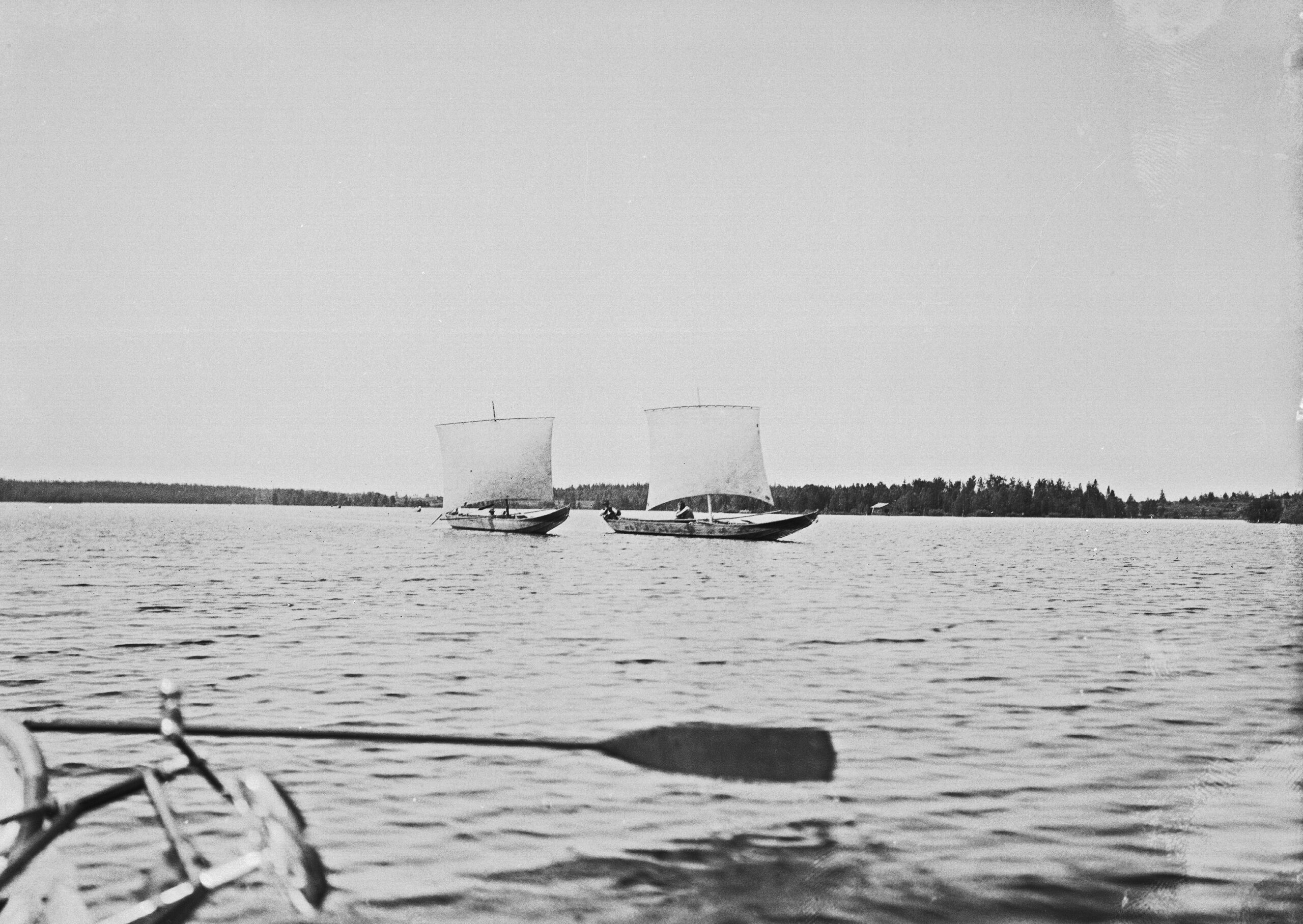Tar transport was at its peak in the 19th century when Oulu was the largest tar port in the world.
Vaalankurkku in the town of Vaala where the Oulujoki river begins was a key place in tar trade and a major transport hub of the time. It was the starting point of the tar route down the river to Oulu.
Tar boats started to come from the lake as soon as the ice had melted. This was usually mid-May, but in 1867, for example, the ice didn’t melt until Midsummer (late June). The best and the busiest period was the heart of the summer from late June to the end of July, but the bravest would row their tar boats even in the autumn storms.
Wind in the sails
At best, the lake could be crossed in one or two days. Antti and Kalle Roivainen, father and son, are said to have set an unofficial record using sails to cross the lake in no more than six hours with a cargo of 30 barrels of tar.
With tailwind, speed could be gained by hoisting a sail made of flax or hemp cloth to the boat – as the men of the Roivainen family did. In favourable conditions, the tar boats virtually raced the lake towards Vaala.
However, the journeys were subject to changes of weather. Headwind slowed down the boats, and stormy weather increased the risk of accidents. A fully loaded tar boat weighed approximately 4,500 kilos and did not ride the waves but pushed straight through. As a result, the lake became the final resting place for some of the less experienced boatmen.
Fleas and bandits
The boatmen sometimes had to wait for more favourable weather in the shelter of the islands – in some cases for weeks for storms to subside. Even though bread, butter and salted and dried fish were packed for the journey, they sometimes ran out of food as the journey dragged on. Bandits could also steal their rations and even the sails of the boats in the dark of night.
A popular place to rest during storms on Ärjänselkä, the widest open expanse of the lake, was Kaivanto, where you could even get inside a house to rest. It was said that the big fleas of Kaivanto would make happy noises when they saw new arrivals coming.
In the shelter of the islands, time was spent telling stories. On Niskanselkä, another long and open expanse of the lake, are the islands of Upper Mulkku and Lower Mulkku (vernacular for the male genital), whose names are a legacy of stories told by fatigued and bored tar rowers who grew tired of waiting.
After reaching Vaalankurkku, the tar rowers stopped to have coffee, often staying overnight and waiting for rivermen to be available before continuing their 100-kilometre journey down the river. On the busiest days, there could be dozens of boats in Vaala heading towards Oulu and a similar number returning up the river.
Another waiting point along the route was at Merilä before the Pyhäkoski rapids, where the boats had to wait for a riverman to take them safely through the rapids.
Fading of the tar business
Initially, tar was transported in short boats that could hold an average of 15 barrels. After the river was dredged, the rapids became less dangerous. Thanks to this, the boats could be made bigger and were able carry twice as much tar.
The tar boats were light but sturdy, built of boards riveted together. However, not many boats were made in areas near the river or the lake as boats could be bought cheaply from traders returning from Oulu.
In the early 20th century, the tar trade gradually began to slow down. The era of wooden ships faded, reducing the need for tar that was used to protect the hulls. Tar burning was replaced by more profitable uses of forest materials, such as the sawmill industry. Agriculture also increased, and the great fire that destroyed the tar warehouses in Oulu also played a part in the end tar trade.
There are only guesses as to when the last tar boat crossed the lake, but locals recall still seeing some tar boats on the lake at the turn of the 1920s and the 1930s.
Sources:
Enbuske, Matti 2010. Pohjois-Pohjanmaan ympäristöhistoria ("Environmental history of North Ostrobothnia"). Center for Economic Development, Transport and the Environment North Ostrobothnia, Environment and Natural Resources. Oulu: Center for Economic Development, Transport and the Environment North Ostrobothnia.
Heikkinen, Reijo 2007. Avara Oulujärvi: Elämää Oulujärvellä ja sen rantamilla ("The Wide Expanse of Lake Oulujärvi: Life on the Lake and Its Shores"). Kajaani.
Heikkinen, Reijo and Mielikäinen, Jussi 1989. Oulujärvi – Kainuun meri ("Lake Oulu – The Sea of Kainuu"). Kuopio: Kustannuskiila.
Inha I.K. 1909. Suomen maisemia. Näkemänsä mukaan kuvaillut ("Finnish Landscapes as Described by an Eyewitness"). Porvoo: WSOY.
Kauhanen, Jouni 2022. Historian lastuja IV. Pienoiselämäkertoja, liikenteen ja sodan historiaa. ("Small Stories of History, Part Four: Mini-biographies and Histories of Traffic and Wartime") Vaala: Säräisniemi Museum and Local Heritage Association.
Kauhanen, Jouni 2023. Tervan perintö ("The Tar Legacy"). Documentary film. Oulu University of Applied Sciences.
Kauppila, Raili and Suihko, Anneli 1987. Tervan tie ("The Road of Tar"). City of Kajaani.
Mäkelä, Simo (ed.) 2000. Vaala – Oulujärven pitäjä ("Vaala – The Municipality of the Lake"). Encyclopedia Vaalaensis. Municipality of Vaala.
Oulujoki River Limited Company 1954. Entinen Oulujoki: historiikkia ja muistitietoa ("The Oulu River of Old: Histories and Recollections").

